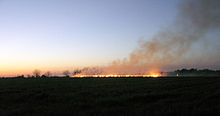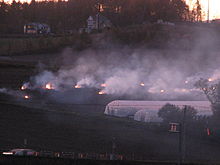- Controlled burn
-
"Back-burn" redirects here. For the village in Scotland, see Backburn.
Part of a series on
Wildland
Firefighting
Main articles Wildfire · Bushfires · Wildfire suppression
Tactics & Equipment Aerial firefighting · Controlled burn · Firebreak · Fire trail · Fire lookout tower · Fire-retardant gel · Fire fighting foam · Fire retardant · Helicopter bucket · Driptorch
Personnel Handcrew · Hotshots · Helitack · Smokejumper · Rappeller · Engine crew
Lists List of wildfires
Glossary of wildfire terms Controlled burning of a field outside of Statesboro, Georgia, United States in preparation for spring planting
Controlled burning of a field outside of Statesboro, Georgia, United States in preparation for spring planting Japanese-Noyaki (Hokkaido)
Japanese-Noyaki (Hokkaido)
Controlled or prescribed burning, also known as hazard reduction burning or Swailing is a technique sometimes used in forest management, farming, prairie restoration or greenhouse gas abatement. Fire is a natural part of both forest and grassland ecology and controlled fire can be a tool for foresters. Hazard reduction or controlled burning is conducted during the cooler months to reduce fuel buildup and decrease the likelihood of serious hotter fires.[1] Controlled burning stimulates the germination of some desirable forest trees, thus renewing the forest. Some cones, such as sequoia and serotinous require heat from fire to open cones to disperse seeds.
In industrialized countries, controlled burning is usually overseen by fire control authorities for regulations and permits. The party responsible must delineate the intended time and place. Obtaining a permit may not limit liability if the fire burns out of control.
Contents
Back burning
Back burning[2] is a way of reducing the amount of flammable material during a bushfire by starting small fires along a man made or natural firebreak in front of a main fire front. It is called back burning because the small fires are designed to 'burn back towards the main fire front'. The basic reason for back burning is so that there is little material that can burn when the main fire reaches the burnt area. The firebreaks that may be used to start a line of fires along could be a river, road or a bulldozed clearing etc.[3]
Forest use
Another consideration is the issue of fire prevention. In Florida, during the drought in 1998, catastrophic wildfires burned numerous homes. But forestry managers in the Florida Division of Forestry noted that the underlying problem was previous cessation of controlled burning, resulting from complaints by homeowners[citation needed]. Each year additional leaf litter and dropped branches increased the likelihood of a hot and uncontrollable fire.[4]
Controlled burns are sometimes ignited using a tool known as the driptorch, which allows a steady stream of flaming fuel to be directed to the ground as needed. Variations on the driptorch can be used such as the helitorch, which is mounted on a helicopter, or other improvised devices such as mounting a driptorch-like device on the side of a vehicle. A pyrotechnic device known as a fusee can be used for ignition in nearby fuels while a Very pistol can be for fuels farther away.
For the burning of slash, waste materials left over from logging, there are several types of controlled burns. Broadcast burning is the burning of scattered slash over a wide area. Pile burning is gathering up the slash into piles before burning. These burning piles may be referred to as bonfires. High temperatures can harm the soil, damaging it physically, chemically or sterilizing it. Broadcast burns tend to have lower temperatures and will not harm the soil as much as pile burning[5], though steps can be taken to treat the soil after a burn. In lop and scatter burning, slash is left to compact over time, or is compacted with machinery. This produces a lower intensity fire, as long as the slash is not packed too tightly[5]. However, soil may be damaged if machinery is used to compress the slash.
Controlled burning reduces fuels, may improve wildlife habitat[6], controls competing vegetation, improves short term forage for grazing, improves accessibility, helps control tree disease, and perpetuates fire dependent species[7]. In mature Longleaf Pine forest, it helps maintain habitat for endangered Red-cockaded Woodpeckers in their sandhill and flatwoods habitats[8]. Fire is also felt to be a crucial element of the recovery of the threatened Louisiana Pine Snake in the longleaf pine forests of central Louisiana and eastern Texas[9]. However many scientists[who?] disagree with such a simplistic approach, and indicate that each forest must be assessed on its own merit[citation needed].
Agricultural use
Controlled burns were first used significantly in the Neolithic Revolution[citation needed], i.e. about 9–11,000 years ago at the end of the last ice age when hunter gatherers turned to farming. In the developing world, this is often referred to as slash and burn.
In addition to forest management, controlled burning is also used in agriculture. In industrialized nations, it is seen as one component of shifting cultivation, as a part of field preparation for planting. Often called field burning, this technique is used to clear the land of any existing crop residue as well as kill weeds and weed seeds. Field burning is less expensive than most other methods such as herbicides or tillage but because it does produce smoke and other fire related pollutants, its use is not popular in agricultural areas bounded by residential housing.
In the United States, field burning is a legislative and regulatory issue at both the Federal and state levels of government.
Controversy
In Oregon, field burning has been widely used by grass seed farmers as a method for clearing fields for the next round of planting, as well as revitalizing grasses that require fire in order to grow seed again. The Oregon Department of Environmental Quality began requiring a permit for farmers to burn their fields in 1981, but the requirements became stricter in 1988 following a multi-car accident[10] in which smoke from field burning near Albany, Oregon obscured the vision of drivers on Interstate 5, leading to a 23-car accident in which 5 people died and 37 were injured.[11] This resulted in more scrutiny of field burning and proposals to ban field burning in the state altogether.[12][13][14]
Following extensive research and advocacy from the Western Environmental Law Center, in 2007 the Lane County Board of Commissioners and the Lane County Board of Health decided to formally urge the state’s Environmental Quality Commission (EQC) to order a two-year moratorium of open field burning in the Willamette Valley in order to protect Oregonians from smoke inhalation from burning grass seed fields[citation needed].
Heathland use
The controlled burning or Swailing of heathland is used in the United Kingdom and other countries as a conservation tool. In Scotland it is known as Muirburn. [15] Often it is used as a tool for creating fire breaks to reduce the risk of dangerous outbreaks but is also an important mechanism for preventing succession to woodier vegetation and plays an important role in the life cycle of heather species.[16]
Greenhouse gas abatement
 Northern California fire crews set fire back burn to stop the Poomacha fire from advancing westward.[17]
Northern California fire crews set fire back burn to stop the Poomacha fire from advancing westward.[17]
Controlled burns on Australian savannas can result in an overall reduction of greenhouse gas emissions. One working example is the West Arnhem Fire Management Agreement, started to bring "strategic fire management across 28,000 square kilometres (11,000 sq mi) of Western Arnhem Land" to partially offset greenhouse gas emissions from a liquefied natural gas plant in Darwin, Australia. Deliberately starting controlled burns early in the dry season results in a mosaic of burnt and unburnt country which reduces the area of stronger, late dry season fires.[18]
See also
- Agroecology
- Bushfire
- Country Fire Service (South Australia)
- Country Fire Authority (Victoria, Australia)
- Fire ecology
- Firebreak
- Fire-stick farming
- Flora of Australia
- New South Wales Rural Fire Service (Australia)
- Shifting cultivation
- Wildfire suppression
- Women in firefighting
References
- ^ Guidelines for Low Intensity Bushfire Hazard Redustion Burning Retrieved on 11-3-2009
- ^ What is Hazard Reduction? Retrieved on 10-3-2009
- ^ Backburning in controlling bushfires to prevent spreading Retrieved on 10-3-2009
- ^ "Fuel loads, fire regimes, and post-fire fuel dynamics in Florida Keys pine forests". International Journal of Wildland Fire 15: 463–478. 2006. http://www2.fiu.edu/~kopturs/pubs/Sahetal2006.pdf.
- ^ a b Julie E. Korb; Nancy C. Johnson and W. W. Covington (March 2004). "Slash Pile Burning Effects on Soil Biotic and Chemical Properties and Plant Establishment: Recommendations for Amelioration". Restoration Ecology 12 (1): 52–62. http://library.eri.nau.edu/gsdl/collect/erilibra/index/assoc/HASHe36c.dir/doc.pdf.
- ^ "Whither wildlife without fire?". Treesearch.fs.fed.us. 2011-06-16. http://www.treesearch.fs.fed.us/pubs/443. Retrieved 2011-06-25.
- ^ "Reasons For Prescribed Fire In Forest Resource Management - A Guide for Prescribed Fire in Southern Forests". Bugwood.org. 2003-03-24. http://www.bugwood.org/pfire/reasons.html. Retrieved 2011-06-25.
- ^ "Red-cockaded Woodpecker" (PDF). http://www.dnr.sc.gov/cwcs/pdf/Redcockadedwoodpecker.pdf. Retrieved 2011-06-25.
- ^ http://www.fws.gov/southwest/clearlakees/PDF/PINESNAKE.pdf
- ^ [1][dead link]
- ^ [2][dead link]
- ^ 2008[dead link]
- ^ Mortensen, Camilla. "Blowing Smoke". Eugene Weekly. http://www.eugeneweekly.com/2008/07/24/coverstory.html. Retrieved 2011-06-25.
- ^ http://www.kmtr.com/news/local/story.aspx?content_id=3500afae-7a5f-414c-9d7d-4e191b911cce
- ^ "Guidance for the controlled burning of heather, grass and other moorland, in Scotlandand other moorland, in Scotland". http://www.scotland.gov.uk/Publications/2004/11/20194/46113.
- ^ "UK: The Role of Fire in the Ecology of Heathland in Southern Britain (IFFN No. 18 - January 1998)". Fire.uni-freiburg.de. http://www.fire.uni-freiburg.de/iffn/country/gb/gb_1.htm. Retrieved 2011-06-25.
- ^ "Homeland Security Budget-in-Brief Fiscal Year 2009". United States Department of Homeland Security. 2009. p. 71. http://www.dhs.gov/xlibrary/assets/budget_bib-fy2009.pdf. Retrieved 31 January 2010.
- ^ "West Arnhem Land Fire Abatement Project". Tropical Savannas CRC, Savanna Information. Tropical Savannas Cooperative Research Centre. http://savanna.cdu.edu.au/information/arnhem_fire_project.html. Retrieved 2007-10-08.
External links
- BBC News Devon Swailing
- Northern Arizona University
- Tall Timbers Research Center and Land Conservancy
- U.S. National Park Service Prescribed Fire Policy
- Savanna Oak Foundation article on controlled burns
- http://www.epa.gov/oecaagct/tburn.html United States Environmental Protection Agency (EPA) article concerning air pollution consequences of controlled burning
- The Nature Conservancy's Global Fire Initiative
- Strategic fire management West Arnhem Land Fire Abatement Project, Tropical Savannas Cooperative Research Centre
- Fire management and greenhouse gas emissions West Arnhem Land Fire Abatement Project, Tropical Savannas CRC
- Fuel Characteristic Classification System (FCCS) for Wildland Fuels
- European Commission project: FIRE PARADOX - "Learn to live with fire"
- "Controlled burn" from the Global Legal Information Network Subject Term Index
Categories:- Wildfire ecology
- Wildfire prevention
- Habitat management equipment and methods
- Agriculture
- Wildfires
Wikimedia Foundation. 2010.




